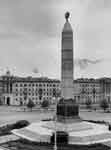Victory Monument
On the 4th of July 2004 Belarus marks 50 years since the opening of Victory Monument in Minsk City – the monument to the Soviet Army soldiers and Belarusian partisans who perished in World War Two. This monument has become a symbol of the Belarusian capital.
As early as the autumn of 1942, Belarusian architect Georgi Zaborski, who had been seriously wounded and was staying in a hospital in the town of Troitsk in the Urals, began making sketches and drawings for a monument to the war heroes. At the end of 1945, he came back to Minsk and became engaged in the restoration of the destroyed Belarusian towns and villages.
In the autumn of 1950, the Administration for Architectural Affairs under the Council of Ministers of Belarus announced a competition for the design of a monument to the Soviet Army soldiers and Belarusian partisans. Over 70 architects and sculptors from Moscow, Leningrad (now St. Petersburg), Minsk, Riga and other cities of the Soviet Union participated in the competition. The first prize was awarded to the design by Georgi Zaborski. For the elaboration of the final design, one more competition was held. The design by G.V. Zaborski and V.A. Korol was judged the best. The leading Belarusian sculptors Z.Azgur, A. Bembel, A. Glebov, S. Selikhanov worked together with the architects to create this monument.
Victory Monument is a dominant figure in the architectural ensemble of Victory Square and serves as a compositional link for Independence Avenue, the main thoroughfare of Minsk City, ending up its perspective. Forty meters high and classic in shape, the obelisk is faced with grey granite and is crowned with the Order of Lenin made of bronze and multicoloured mosaics. The obelisk faces are covered with high relief ribbons with Belarusian national pattern. A large stepped foundation of the obelisk is decorated with 4 bronze high reliefs. These are the ‘May 9, 1945’ (sculptor A.Bembel) depicting the triumph of victory, with the state emblem of Belarus above, ‘The Soviet Army in World War II’ (sculptor S.Selikhanov) and ‘Belarusian partisans’ (sculptor A. Glebov) depicting some episodes from the ‘railroad war’ and a combat battle, and the ‘Glory to the perished heroes’ (sculptor Z. Azgur) depicting the people’s grief over a hero’s grave. These sculptural compositions, performed in a realistic manner with a detail elaboration of relief imprints, highlight the culmination points in the struggle of the Belarusian people against the German-Fascist invaders.
The obelisk is mounted on a wide octagonal stepped podium embellished with 4 bronze wreaths placed on huge cubic stylobates of black labradorite. They serve as symbols of 4 fronts that participated in the liberation of Belarus from the Nazi occupiers. At the foot of the obelisk is a bronze sword covered with laurel wreath as a symbol of victory (sculptor S. Saltykov). On July 3, 1961, the 17th anniversary of Belarus liberation, the Eternal Flame was lit before the monument.
In 1984, due to the opening of Minsk Metro, the square in front of the monument was reconstructed (architects B. Larchenko, B. Shkolnikov, K. Viazgin). It was designed on two levels. The obelisk’s foundation underground is circled by a passage gallery connected to the metro station. The gallery runs into a memorial hall to the heroes and victims of WWII. In the center of the hall there is an illuminated wreath of coloured glass (artist V. Pozniak) – a symbol of the Eternal flame of memory. On the wall is the bronze bas-relief of the Star of the Hero of the Soviet Union and the memorial plaques with the names of 566 natives of Belarus and other Soviet republics, who gave their lifes to liberate Belarus from the Nazi invaders and who were awarded the title of the Hero of the USSR. The symmetrical flights of steps entering the square are embellished with massive granite blocks having a bronze depiction of lowered flags on their upper sloping faces (sculptor N. Ryzhenkov). The entrance to the monument is decorated with small granite blocks with the inscriptions of the Soviet cities-heroes and the images of their awards.
In 2004, the monument and the adjacent area were renewed (chief architect of the project V.I. Bakaev).
Documents relating to the construction and restoration of the monument (drawings, sketches, competition designs and photographs) are held at the Belarusian State Archives of Scientific and Technical Documentation (BGANTD).
Draft designs [the 1950s]
 |
 |
 |
 |




